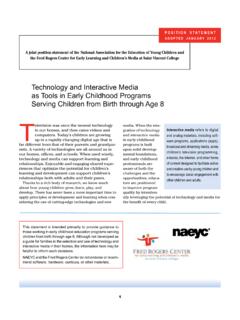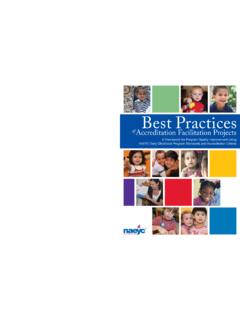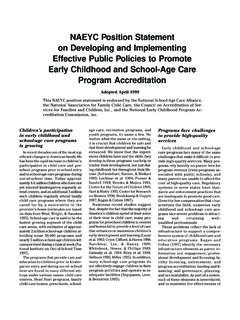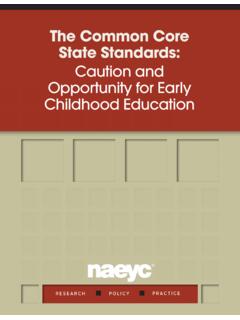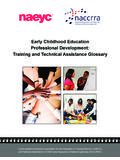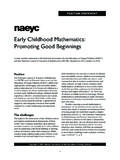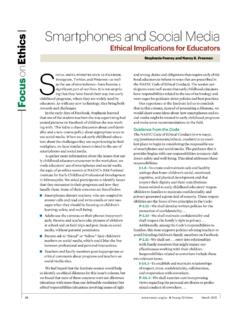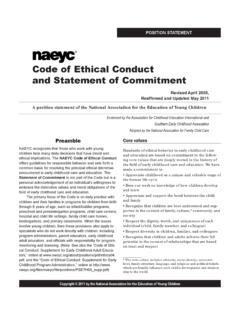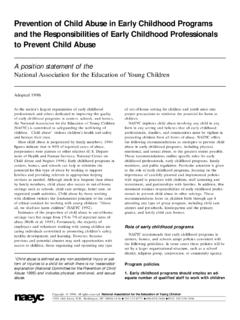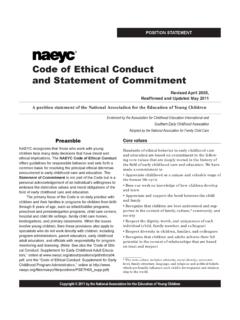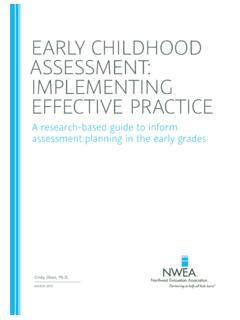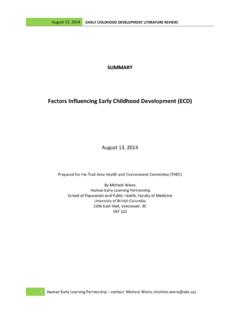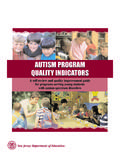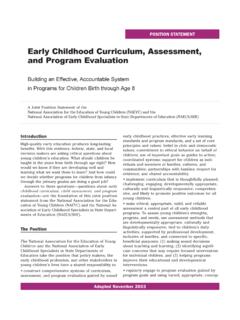Transcription of Early Childhood Curriculum, Assessment, and Program …
1 1 IntroductionHigh-quality Early education produces long-lastingbenefits (Schweinhart & Weikart 1997; National Re-search Council & Institute of Medicine 2000; Peisner-Feinberg et al. 2000; National Research Council 2001;Reynolds et al. 2001; Campbell et al. 2002). With thisevidence, federal, state, and local decision makers areasking critical questions about young children s educa-tion. What should children be taught in the years frombirth through age eight? How would we know if they aredeveloping well and learning what we want them tolearn?
2 And how could we decide whether programs forchildren from infancy through the primary grades aredoing a good job?Answers to these questions questions about earlychildhood curriculum , child assessment , and Program evalu-ation are the foundation of the joint position statementfrom the National Association for the Education of YoungChildren (NAEYC) and the National Association of EarlyChildhood Specialists in State Departments of Education(NAECS/SDE).OverviewThis document begins by summarizing the position ofNAEYC and NAECS/SDE about what is needed in aneffective system of Early Childhood education asystem that supports a reciprocal relationship amongcurriculum, child assessment , and Program , the document outlines the position statement sbackground and intended effects.
3 It describes the majortrends, new understandings, and contemporary issuesthat have influenced the position statement s recom-mendations. With this background, the document thenoutlines the principles and values that guide an inter-connected system of curriculum , child assessment , andprogram evaluation. We emphasize that such a systemmust be linked to and guided by Early learning stan-dards and Early Childhood Program standards that areconsistent with professional recommendations (NAEYC& NAECS/SDE 2002; NAEYC 2003).
4 Next, key recommendations, rationales, and indica-tors of effectiveness are presented for each of thesecomponents, accompanied by frequently asked ques-tions. Although the recommendations and indicatorswill generally apply to children across the birth eightage range, in many cases the recommendations needdevelopmental adaptation and fine-tuning. Wherepossible, the position statement notes these adapta-tions or special considerations. To further illustratethese developmental considerations, each componentis accompanied by a chart (pp.)
5 19-26) that gives ex-amples of how the recommendations would be imple-mented with infants and toddlers, preschoolers, andkindergarten-primary grade children. This resourceconcludes by describing examples of the support andresources needed to develop effective systems ofcurriculum, child assessment , and Program Childhood curriculum , Assessment, and Program EvaluationBuilding an Effective, Accountable Systemin programs for Children Birth through Age 8 POSITION STATEMENTWITH EXPANDED RESOURCESThis resource is based on the 2003 Joint Position Statement of the National Association for the Education ofYoung Children (NAEYC)
6 And the National Association of Early Childhood Specialists in State Departments ofEducation (NAECS/SDE). It includes the statement of position, recommendations, and indicators of effectivenessof the position statement, as well as an overview of relevant trends and issues, guiding principles and values, arationale for each recommendation, frequently asked questions, and developmental Statement Adopted November 20032 The PositionThe National Association for the Education of YoungChildren and the National Association of Early Child-hood Specialists in State Departments of Education takethe position that policy makers.
7 The Early childhoodprofession, and other stakeholders in young children slives have a shared responsibility to construct comprehensive systems of Curriculum, assessment , and Program evaluation guided by soundearly Childhood practices, effective Early learningstandards and Program standards, and a set of coreprinciples and values: belief in civic and democraticvalues; commitment to ethical behavior on behalf ofchildren; use of important goals as guides to action;coordinated systems; support for children as individu-als and members of families, cultures,1 and communi-ties; partnerships with families; respect for evidence;and shared accountability.
8 Implement curriculum that is thoughtfully planned,challenging, engaging, developmentally appropriate,2culturally and linguistically responsive, comprehensive,and likely to promote positive outcomes for all youngchildren. make ethical, appropriate, valid, and reliable assess-ment a central part of all Early Childhood programs . Toassess young children s strengths, progress, and needs,use assessment methods that are developmentallyappropriate, culturally and linguistically responsive,tied to children s daily activities, supported by profes-sional development, inclusive of families, and con-nected to specific, beneficial purposes.
9 (1) makingsound decisions about teaching and learning, (2)identifying significant concerns that may requirefocused intervention for individual children, and (3)helping programs improve their educational anddevelopmental interventions. regularly engage in Program evaluation guided byprogram goals and using varied, appropriate, conceptu-ally and technically sound evidence, to determine theextent to which programs meet the expected standardsof quality and to examine intended as well as unin-tended results. provide the support, professional development, andother resources to allow staff in Early childhoodprograms to implement high-quality Curriculum, assessment , and Program evaluation practices and toconnect those practices with well-defined Early learningstandards and Program Statements Intended EffectsIn developing and disseminating position state-ments, NAEYC, NAECS/SDE, and their partnerorganizations aim to take informed positions on significant.
10 Controver-sial issues affecting young children s educationand development3 in this case, issues related tocurriculum development and implementation, thepurposes and uses of assessment data, andbenefits and risks in accountability systems forearly Childhood programs . promote broad-based dialogue on these issues,within and beyond the Early Childhood field. create a shared language and evidence-basedframe of reference so that practitioners, decisionmakers, and families may talk together about earlychildhood curriculum , assessment , and programevaluation and their relationship to Early learningstandards and Program standards.
